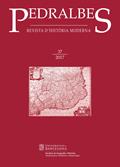Los confesores y los relatos autobiográficos de monjas en la transición del siglo XVI al siglo XVII: Hipólita de Rocabertí y Ana Domenge
DOI:
https://doi.org/10.1344/pedralbes2017.37.5Keywords:
narratives, autobiography, nuns, hagiography, confessorAbstract
Confessors and nuns’ autobiografical narratives in the 16th and 17th centuries. Hipólita de Rocabertí and Ana Domenge
In this paper we analyze, on the one hand, the capacity of influence that confessors had in nuns’ autobiographical narratives and, on the other, the reputed female will reflected in these. Teresa de Jesus always shied away from excessive dependence on confessors; the risks of manipulation of the nuns’ conscience were evident. We analyze the cases of two Dominican nuns: Hipólita de Rocabertí and Ana Domenge, together with the significant process that the Inquisition put the first confessor of the latter through, Friar Antonio Darnils. We explore the complex confessor-nun dialectic, and the hagiographic vocation of public exemplariness with which narratives were written.
Downloads
Published
How to Cite
Issue
Section
License
Copyright (c) 2017 Rosa Maria Alabrús Iglesias

This work is licensed under a Creative Commons Attribution-ShareAlike 4.0 International License.
Authors must agree with the following terms:
1. The author keeps authorship rights, ceding the journal the right to first publication.
2. Texts will be disseminated with a Creative Commons Attribution 4.0 International License. Which allows for the work to be shared with third parties, as long as they recognise the work’s authorship, the original publication in the journal and licensing conditions.
This requires acknowledging authorship appropriately, providing a link to the license, and indicating if any changes have been made. It can be indicated in any reasonable way, but not in a manner that suggests the licensor endorses or sponsors the use of the text.
If content is remixed, transformed, or new content is created from the journal's texts, it must be distributed under the same license as the original text



